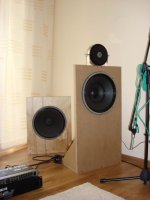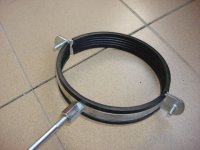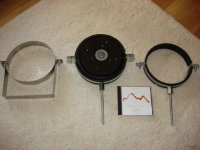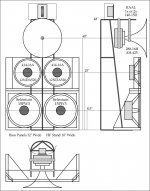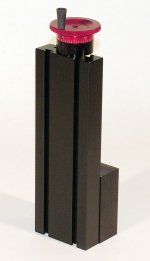Lynn Olson said:Hi Caninus80!
P.S. About cameras - just about impossible to go wrong with Canon, Nikon, Pentax, or Sony DSL's. They are all really, really good, and can yield professional results in skilled hands. But they have a very long learning curve, which I found out after buying my Pentax K10D. My first SLR was a Pentax Spotmatic that I bought new in 1964, my second was a Nikon FE2 that I bought new in 1984, I've developed my own Tri-X and printed my own prints on DuPont and Ilford papers during the early Seventies, and I've used full Photoshop on a high-end Macintosh since 1999.
With this background, I thought I'd master the K10D in a matter of days. Wrong. Using digital to its full quality takes a different set of skills than film. In terms of tonal qualities, it's a bit like shooting very fast Kodachrome that is much easier to color-balance. It took me six months to finally graduate to shooting everything in RAW mode, and the skills to master Photoshop so that I could take advantage of the extra quality and flexibility. The DSLR's above entry-level take a surprising amount of time to master - they are very different animals than point-n-shoot cameras.
I will mention that each brand of camera seems to have a different color palette from each other, and it take a fair amount of time in Photoshop to make the shots have a similar color "character". I like the rendition of Canon and Pentax best, and am less fond of the Nikon and Sony look. Yes, you can make one camera look like another - but it's rather tedious and pointless, and saves time if you like the inherent set of choices that the camera vendor built into the camera as color-processing defaults.
Spot on.
Just want to add Olympus as my old time favourite from analogue SLR times. Makes pretty beautiful 3/4 th's now but not that much to recommend in the pocket sector – besides the discontinued C-7000Z IMO.
Greetings
Michael
Lynn Olson said:
Well, I hate to throw cold water on this and antagonize the JBL fans, but the Ranger-Paragon was one of the biggest disappointments I've ever had in audio. They are absolutely stunning-looking loudspeakers "in person", far more beautiful than the pictures suggest. Most definitely Museum of Modern Art-worthy - the only word I can use is "icon", like an iPod or iPhone.
Imaging? None. The theory of the curved panel doesn't work - it just creates a zillion reflections, a very hollow-sounding midrange, and scrambles the stereo even more. The Ranger-Paragon is an object example in the sound of early reflections combined with large, resonant structures that are close to the drivers.
Well, now that's I've knocked one of the most iconic (so to speak) speakers ever made, I'm not expecting any love letters from JBL fans. But I heard what I heard, way back then, and it really sounded pretty awful. In terms of a huge gulf between ambitious advertising claims and the acoustic results, the Ranger-Paragon is right up there with the Karlson.
A classic example of looking good and sounding good are not the same thing. I loved JBL products for a long time, thats all I used to own, but the Paragon was a disaster. I still thought that they made good drivers after that. Now I find that their stuff is just expensive.
Lynn Olson said:Hi Caninus80!
One experiment you might want to try in the future is placing the diaphragm of the 399 a few inches behind the dustcap of the midbass driver - I'd start with 4~6 inches based on my fooling around with time-aligning a Klipsch Chorus, which combines a 15" midbass with a mid and HF horn. (See results here.) It was the relative simplicity of the brief experiments with the Klipsch that gave me the confidence to even try horns in the first place.
Lynn,
Of course I will try with placing 399. This CD is my first one, so now I will make some experiments with mounting... What You see on the photo is set-up only to make measurements (today I got my first measurement
system- behringer mc8000 mic, behringer 802 pre and m-audio transit)
So I will have fun
Attachments
gedlee said:
A classic example of looking good and sounding good are not the same thing. I loved JBL products for a long time, thats all I used to own, but the Paragon was a disaster. I still thought that they made good drivers after that. Now I find that their stuff is just expensive.
Yes, the Ranger-Paragon was sooo good-looking, along with the beautiful Barzilay Brazilian Rosewood equipment cabinets with elegant multisection sliding "tambour" doors. So classy and elegant-looking. But the sound ... oh well.
My friend Tony Glynn (of Lowther USA) liked Stephens Tru-Sonic - he described them as the best-sounding speaker of the day, far above Altec, JBL, and Klipsch. I didn't realize that Bob Stephens was the co-designer of the Shearer Theater Speaker in 1936, and would have had a low opinion of the funky sectoral horns that Altec was pushing in the consumer market.
When you separate the marketing puff from the Eames Three-Way, there seems to be a good loudspeaker in there. The 15" midbass goes up to 800 Hz, the big multicell covers 800 Hz to 5 kHz, the smaller tweeter takes over at 5 kHz, which look like good choices considering the dispersion characteristics of the three drivers.
The conservative choice of crossover points is also relevant considering the lack of knowledge of driver equalization and impedance correction techniques fifty years ago. Modern crossover design and Theile/Small theory were still fifteen years in the future. We can cut the mid-Fifties folks a little slack on the oddball bass-loading theories of the day - modern filter theory was the domain of the military, aerospace, radar, and leading-edge color-TV engineers, not audio. It took more than a decade for Theile's paper to make it from an obscure Australian journal to the august pages of the Journal of the Audio Engineering Society.
The Eames pictures look nice, although I doubt anything could match the Ranger-Paragon for sheer room-filling beauty. The price of the Eames Three-Way is a little sobering - US$540 for a single loudspeaker was a lot of money back in 1958. Gold was $35/oz, a nice Chevrolet with V8 engine was about $1400, and a pleasant house in a good neighborhood was $10,000.
Looking back, I'd guess the best speakers fifty years ago were probably the Quad ESL-57, the AR-1W with the Janszen Z-130 tweeter, the 12" and 15" Tannoy Dual Concentrics, and the Stephens Tru-Sonic lineup - maybe the larger Bozak models too, but I've never heard the Stephens or the Bozaks.
P.S. This is a real audio classic. Check out the authentic Fifties decor on Page Four.
Lynn Olson said:Yes, the Ranger-Paragon was sooo good-looking, along with the beautiful Barzilay Brazilian Rosewood equipment cabinets with elegant multisection sliding "tambour" doors. So classy and elegant-looking. But the sound ... oh well.
Well, at least we can agreed on this point. Paragon is just beautiful. Another fact is that most people buy speakers based strictly on look, as they have no clue what a speaker should sound like.
Moreover, how many speakers actually go UP in price after you purchased it? Not many.
Paragon has a lot of problems, for examples.
The cabinet is too low. Maybe, even too small,
The bass drivers are not coupled to the ground,
The sound from the mid horns bounce off the curved panel,
The sound from mid horns bounce off the curved panel, but the tweeters do not.
etc
etc
But I think the basic technical design of a Paragon, a single-point source, 3 way horn system is applicable here. I think we can do better to say that a good sounding speaker must look ugly. Sorry, Dr. Gedlee.
For starter, the Paragon can be heightened from 24" to 36" in height; extend the bass horn to the floor; and if bouncing off a curved surface is a bad idea, then flip the curved surface backward. Make the cutoff of the bass horn to 77Hz.
I still have not figure out the time alignment problem(translation: I don't have a clue how to do time alignment without going digital). My suspicion is that time alignment is the reason why JBL put the tweeters where they are.
My point is that there is no reason to make an ugly speaker. If it is not ugly, then there will be no WAF to deal with. WAF has nothing to do with how big the speakers are.
agent.5 said:WAF has nothing to do with how big the speakers are.
You're kidding right? Have you talked to many wives...
robertwb70 said:
You're kidding right? Have you talked to many wives...
Honestly, No. But I doubt many wives have seen a picture of the paragon either.
I see reference to WAF all the time, I don't get this at all. How can the person who loves you not deal with the hobby you love. I get absolutely no grief about my speakers, other stereo equipment or music collection. I give my wife no hassle with the hobbies she loves, we are in this life together as partners. I thinks some perspective and priorities are in order. My biggest worry regarding my several GIANT speakers are my kids putting a finger or stick through one, but I deal with this because I love them and they're current hobby is playing with sticks and destroying things, just like I did when I was they're age.
mordikai said:I see reference to WAF all the time, I don't get this at all. How can the person who loves you not deal with the hobby you love. I get absolutely no grief about my speakers, other stereo equipment or music collection. I give my wife no hassle with the hobbies she loves, we are in this life together as partners. I thinks some perspective and priorities are in order. My biggest worry regarding my several GIANT speakers are my kids putting a finger or stick through one, but I deal with this because I love them and they're current hobby is playing with sticks and destroying things, just like I did when I was they're age.
An externally hosted image should be here but it was not working when we last tested it.
My wife is very tolerant BUT these were butt ugly!!! She just laughed and ran up stairs when she was shocked to find these in my man cave - I cowered in the corner as she giggled and ran- the next day these were 'retired'

agent.5 said:
Paragon has a lot of problems, for examples.
The cabinet is too low. Maybe, even too small,
The bass drivers are not coupled to the ground,
The sound from the mid horns bounce off the curved panel,
The sound from mid horns bounce off the curved panel, but the tweeters do not.
etc
etc
But I think the basic technical design of a Paragon, a single-point source, 3 way horn system is applicable here.
For starter, the Paragon can be heightened from 24" to 36" in height; extend the bass horn to the floor; and if bouncing off a curved surface is a bad idea, then flip the curved surface backward. Make the cutoff of the bass horn to 77Hz.
I still have not figure out the time alignment problem(translation: I don't have a clue how to do time alignment without going digital). My suspicion is that time alignment is the reason why JBL put the tweeters where they are.
Once again I beg the indulgence of my readers with another story from my Portland days. Back in 1991, when I joined the Oregon Triode Society, everyone wanted to "modify" and "improve" their Dyna Stereo 70 - those ubiquitous amplifiers that Dynaco made in the hundreds of thousands, and still to this day represent a decent-sounding amplifier at a modest price. Matt Kamna did a lot of upgrades for OTS members, and the two of us pencilled out an upgrade path:
Improve the driver and input stage with a much more linear circuit - which involves discarding the tired old circuit board (which is very hard to modify without destroying circuit traces) with a new circuit board, or better, point-to-point wiring with its much lower stray capacitance. Replace the funky, corroded socketry and input/output connectors while you're at it, don't you?
Replace the output tubes with real triodes - a supplementary, or better, brand-new power transformer is a good idea, since the original barely has enough heater current for the original circuit. If you use separate power transformers for Left and Right B+ supplies, the stereo image quality will be substantially improved.
The original chassis is now much too small - better to have a pair of Left and Right monoblock chassis with plenty of room for all of the new goodies. A more spacious layout, by the time you're all done, usually turns out to be just right, or even a little small.
Well golly, those Dyna output transformers were good for the day, but some of the modern output transformers measure and sound better, so why not swap those out too?
The careful reader will note all that is left of the original Dyna Stereo 70 is (one) power cord. Might as well replace that with a modern 3-wire grounded IEC cord.
This isn't entirely the joke it seems - Matt and I have seen people traverse this entire "upgrade" path, leaving behind a ruined Stereo 70 circuit board and chassis in the process, and spending far more than a clean-slate approach would have cost. But in the customer's mind, there's still a Stereo 70 in there somewhere, even though it's only a memory.
In practice, the Stereo 70 owner has to be willing to set limits on how far they want to go. Matt and I encourage people to stay with the "spirit of the design" - small, simple, cost-effective, and true in sonic character to the original. Swap the circuit board for a one using a similar topology and more readily available lower-distortion input and driver tubes, and stop right there.
The same applies to a "retro" speaker. What is worth saving, and what should be discarded?
The "ancients" had no idea how to do Thiele/Small bass alignments, modern filter design, diffraction control, or time-domain optimization. All of that was decades in the future. The Quad ESL-57 is the only "ancient" speaker with truly exemplary time response, for example, and that design is so unusual it doesn't help those of us working with direct-radiators or horns.
Some of the drivers were pretty good, though, going right back to the Western Electric and RCA designs. These drivers became the precursors to all prosound drivers that followed, and sometimes have interesting ideas incorporated as part of them - not everything is revealed in the patents, for example. When we see the hand of Wente, Thuras, Hilliard, Stephens, and Jim Lansing, there's a good chance there are some very clever ideas will present themselves when the driver is disassembled and analyzed with modern tools.
I'm not a collector at all. What interests me are interesting ideas that have been bypassed as the market demands of the audio industry shifted. Over several market cycles, a lot of good ideas have been forgotten and are lying there on the ground, waiting to be picked up and used again. This is why I'm a lot more interested in the ideas embodied in a Western Electric 92A than actually owning the thing - I'll leave that to the Akihibara crowd. I feel the same way about WE and RCA drivers - good ideas that are waiting to be re-discovered. But the actual speakers - well, not so much. I remember what they sounded like.
Applying this approach to the Paragon, what is worth saving? Not the tweeter. Not the midrange. Not the horn-lenses, with their severe time-domain reflections. Not the curved reflecting wood surface. The bass-horn was a disaster, with almost no subjective bass at all. Klipschorns went deeper and louder.
What remains is a really cool name, a marketing legend, a really nice vintage bass driver, and the inspiration to build something beautiful, surely a worthy goal. I don't know if JBL still controls the "Paragon" trade name or not, but I'd be a little careful with a company the size of Harmon International. But the inspiration to use beautiful curved wood - yes! Much prettier and more elegant than modern speakers that look like giant prisms made of kitchen counter-tops.
Hello Lynn
"Not the horn-lenses, with their severe time-domain reflections."
There are no lenses on a Paragon.
"Not the tweeter. Not the midrange."
Great send them to me. I will gladly take the alnico 375/376 or 2440/2441 off your hands. The alnico 075's can be converted to 077's/2405's with a diaphram and horn change. All the alnico ring radiators use a common magnet structure so you can make anything you want out of them.
You can keep the Le-15's.
Rob
"Not the horn-lenses, with their severe time-domain reflections."
There are no lenses on a Paragon.
"Not the tweeter. Not the midrange."
Great send them to me. I will gladly take the alnico 375/376 or 2440/2441 off your hands. The alnico 075's can be converted to 077's/2405's with a diaphram and horn change. All the alnico ring radiators use a common magnet structure so you can make anything you want out of them.
You can keep the Le-15's.
Rob
Applying this approach to the Paragon, what is worth saving?
But the inspiration to use beautiful curved wood - yes! Much prettier and more elegant than modern speakers that look like giant prisms made of kitchen counter-tops. [/B]
Thank you.
It's not a Paragon - or a Parthenon
The purpose of this first go-round is a prototype that can allow different variations of the design. Neither a Paragon nor a Parthenon, it's just something to try out a few concepts in the real world.
The HF driver is suspended from bungee cords, canvas, or fabric mesh, and is adjustable front-to-back, since the time alignment is a function of the crossover, and to a lesser degree, listening distance. This drawing shows the approximate spacing I expect to see between the compression driver and the midbass, based on previous experience with the Klipsch Chorus, which had similar crossover points and a 15" midbass driver and midrange horn.
The upper and lower bass panels are separate, and I plan to try a single 12" midbass driver, two of them as shown here, and a single 15" midbass driver. I'll be trying the Gary Pimm approach to quasi-cardioid, with the Bonded Logic recycled blue jeans damping material that Gary Pimm uses so successfully in his speakers.
As mentioned earlier, the pair of 15" Selenium drivers have their own equalization and power amplifier.
I'll be contacting local Denver-area woodworkers fairly soon - any comments on what you see here? The HF frame will be made from steel or aluminum tubing, and idea is for a rigid frame that has low surface-emission area. Since the compression driver, horn, and ribbon tweeter weigh about 40 lbs all together, and are 48 inches off the floor, I want the HF frame to be stable.
The purpose of this first go-round is a prototype that can allow different variations of the design. Neither a Paragon nor a Parthenon, it's just something to try out a few concepts in the real world.
The HF driver is suspended from bungee cords, canvas, or fabric mesh, and is adjustable front-to-back, since the time alignment is a function of the crossover, and to a lesser degree, listening distance. This drawing shows the approximate spacing I expect to see between the compression driver and the midbass, based on previous experience with the Klipsch Chorus, which had similar crossover points and a 15" midbass driver and midrange horn.
The upper and lower bass panels are separate, and I plan to try a single 12" midbass driver, two of them as shown here, and a single 15" midbass driver. I'll be trying the Gary Pimm approach to quasi-cardioid, with the Bonded Logic recycled blue jeans damping material that Gary Pimm uses so successfully in his speakers.
As mentioned earlier, the pair of 15" Selenium drivers have their own equalization and power amplifier.
I'll be contacting local Denver-area woodworkers fairly soon - any comments on what you see here? The HF frame will be made from steel or aluminum tubing, and idea is for a rigid frame that has low surface-emission area. Since the compression driver, horn, and ribbon tweeter weigh about 40 lbs all together, and are 48 inches off the floor, I want the HF frame to be stable.
Attachments
I think it may be a good idea to provide micro distance adjustments for both RAAL and the mid horns, to facilitate time alignment. Maybe, we can use something like this:
http://www.sherlineipd.com/manslide.htm
http://www.sherlineipd.com/manslide.htm
Attachments
Hello Lynn
What's your seated height?? That ribbon is probably like a JBL 2405/077 ring tweeter. Very tight in the vertical axis. The way it's positioned it does not look like you can angle it down without reflections off the back of the midrange horn. I would think you may want to have it adjustable in both front to back and have an arc like adjustment for height to aim it down if you need too.
Rob
What's your seated height?? That ribbon is probably like a JBL 2405/077 ring tweeter. Very tight in the vertical axis. The way it's positioned it does not look like you can angle it down without reflections off the back of the midrange horn. I would think you may want to have it adjustable in both front to back and have an arc like adjustment for height to aim it down if you need too.
Rob
- Home
- Loudspeakers
- Multi-Way
- Beyond the Ariel
